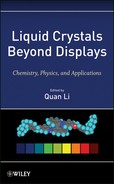Contents
Chapter 1: Liquid Crystal Lasers
Chapter 2: Self-Organized Semiconducting Discotic Liquid Crystals for Optoelectronic Applications
2.2 Charge Transport and Measurements in DLCS
2.3 Discotic Molecular Systems
2.4 Alignment of DLC Materials in Active Semiconducting Layers
2.5 Applications of Self-Assembled DLCs
Chapter 3: Magnetic Liquid Crystals
3.2 Magnetic Anisotropy (Δχ) of LCs
3.4 Paramagnetic Metallomesogens
Chapter 4: Ferroelectric Liquid Crystals for Nonlinear Optical Applications
4.4 Conclusions and Future Prospects
5.2 Survey of Photoinduced Phase Transformation in Liquid Crystals
5.3 Detailed Account of PIPT in Specific Systems
Chapter 6: Light-Driven Chiral Molecular Switches or Motors in Liquid Crystal Media
6.2 Photoresponsive Cholesteric Liquid Crystals
6.3 Light-Driven Molecular Switches or Motors as Dopants
Chapter 7: Liquid Crystal-Functionalized Nano- and Microfibers Produced by Electrospinning
7.1 Introduction: Why Electrospinning With Liquid Crystals?
7.3 Electrospinning of Liquid Crystal Polymers
7.4 Low Molar Mass Liquid Crystals Inside Electrospun Fibers
7.5 Application Potential of Liquid Crystal-Containing Electrospun Fibers
Chapter 8: Functional Liquid Crystalline Block Copolymers: Order Meets Self-Assembled Nanostructures
8.1 What are Functional Liquid Crystalline Block Copolymers?
8.2 Macroscopic Orientation of Nanodomains
8.3 Shape-Memory Materials and Elastomers
8.4 Stimuli-Responsive Vesicles in Solution
Chapter 9: Semiconducting Applications of Polymerizable Liquid Crystals
9.4 Organic Field-Effect Transistors
Chapter 10: Liquid Crystals of Carbon Nanotubes and Carbon Nanotubes in Liquid Crystals
10.2 Dispersion of Carbon Nanotubes
10.3 Liquid Crystal Phases of Carbon Nanotubes
10.4 Carbon Nanotubes Aligned by Thermotropic Liquid Crystals
10.5 Carbon Nanotubes Aligned by Lyotropic Liquid Crystals
10.6 Carbon Nanotubes in Liquid Crystalline Polymers or Polymerized Liquid Crystals
Chapter 11: Liquid Crystals in Metamaterials
11.4 RF Tunable “Meta-Surfaces” with LCs
11.6 Optical Metamaterials with LCs
11.7 LC Interaction with Plasmonic Metamaterial Structures
11.8 Liquid Crystals in Self-Assembled Metamaterials
Chapter 12: Ferroelectric Colloids in Liquid Crystals
12.2 Particles Interaction and the Problem of Colloid Stability
12.3 Preparation of the Ferroelectric Colloids
12.4 Orientational Ordering in Ferroelectric Liquid Crystal Colloids
12.5 Dielectric and Reorientational Properties of Ferroelectric LC Colloids
Chapter 13: Fact or Fiction: Cybotactic Groups in the Nematic Phase of Bent Core Mesogens
13.2 Nematic Phase of Rod-Like Molecules
13.4 Nematic Phase of Bent Core Mesogens
Chapter 14: Lyotropic Chromonic Liquid Crystals: Emerging Applications
14.2 Structures and Phase Properties of LCLCs
14.3 Emerging Applications of LCLCs
Chapter 15: Liquid Crystal-Based Chemical Sensors
15.2 Design of Chemically Functionalized Surfaces for use in LC-Based Chemical Sensors
15.3 LC-Based Sensors for Coordinating Compounds
15.4 LC Sensors Designed to Report Acid–Base Interactions
Chapter 16: Polymer Stabilized Cholesteric Liquid Crystal for Switchable Windows
16.2 Cholesteric Liquid Crystal
16.4 Polymer Stabilized Cholesteric Texture
Chapter 17: Liquid Crystals for Nanophotonics
17.3 Uniform Patterned Growth of Multi-wall Carbon Nanotubes
17.4 Properties of LCs Exploited in Nanophotonic Devices
17.5 The Optics of Nematic Liquid Crystals
17.6 LC Hybrid Systems Doped With Nanotechnology
17.7 Carbon Nanotubes as Electrode Structures
17.8 Nanophotonic Device Characterization
17.9 Carbon Nanotube Electrode Optimization in the Device
17.10 Carbon Nanotube Electrode Optimization: Experimental Results
17.11 Transparent Nanophotonic Device
17.12 Nanophotonic Compound Eye-Based 3D Vision Sensor
17.13 Optical Reconstruction Technique
17.14 Imaging Using the Nanophotonic Lens Array
